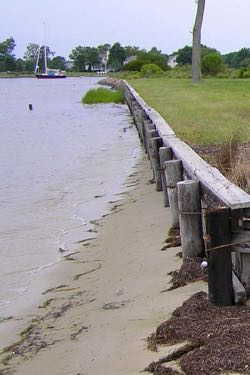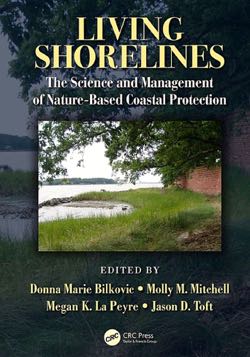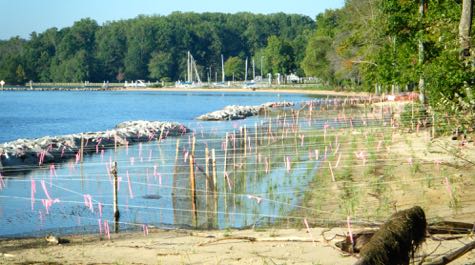VIMS shares benefits, challenges of living shorelines
Researchers serve as editors and authors for new book
Researchers Donna Marie Bilkovic and Molly Mitchell of the Virginia Institute of Marine Science have joined forces with two other editors and a host of authors from VIMS and worldwide on a new book that explores the benefits and challenges of using “living shorelines” to manage coastal erosion and other issues facing waterfront communities.
Unlike traditional structures such as bulkheads—which sever the natural processes connecting land and water—living shorelines use strategic placement of plants, stone, sand, or other materials to reduce erosion and enhance wetland habitat. By preserving the natural connections between water, shoreline, and uplands, they provide better habitat for fish and other animals.
 Bilkovic, the book’s lead editor and a research associate professor in the Center for Coastal Resources Management at VIMS, says Living Shorelines: The Science and Management of Nature-Based Coastal Protection “Serves to summarize what has and hasn't worked in terms of living shoreline approaches, how to navigate through regulations and other hurdles, and what we still need to better understand.”
Bilkovic, the book’s lead editor and a research associate professor in the Center for Coastal Resources Management at VIMS, says Living Shorelines: The Science and Management of Nature-Based Coastal Protection “Serves to summarize what has and hasn't worked in terms of living shoreline approaches, how to navigate through regulations and other hurdles, and what we still need to better understand.”
“I think it’s the first book of its kind,” says Mitchell. “Our goal was to synthesize research done here at VIMS, nationally, and internationally on designing living shorelines to maximize coastal protection and ecological systems.”
Based largely on a VIMS report describing their many benefits, Virginia’s General Assembly in 2011 enacted living shorelines as the preferred alternative for stabilizing tidal shorelines in the Commonwealth. They are also growing in popularity and use around the U.S. and world.
But living shorelines are not the best solution for every shoreline situation. In the new book, Bilkovic, Mitchell, and co-editors Megan La Peyre and Jason Toft compile detailed discussions of the social, regulatory, and technical considerations needed to justify and design living-shoreline projects, including lessons learned from shoreline restoration and conservation projects in Chesapeake Bay, the mid-Atlantic, the Gulf and West coasts of the U.S., and in Canada, Europe, and Australia.
“One of our goals,” says Bilkovic, “was to synthesize regional perspectives to identify the strategies needed to successfully design and implement a living shoreline in a particular location.”
In addition to an introductory “Primer to Living Shorelines” and a closing “Synthesis of Living Shoreline Perspectives” penned by the editors, the 24-chapter volume includes contributions by more than 70 other authors.
A chapter by VIMS assistant professor Aaron Beck, William & Mary professor Randy Chambers, Mitchell, and Bilkovic evaluates living-shoreline marshes as a tool for reducing nitrogen pollution in coastal systems. Another chapter, by Bilkovic and Mitchell, describes how the salt marsh ecosystems associated with living shorelines can be best designed to promote coastal resilience.
Audience
Bilkovic says the intended audience for the volume includes scientists, managers, planners, regulators, consultants, contractors, and property owners. “To successfully implement living shorelines,” she says, “there needs to be open communication among these groups. Unfortunately, important information is often buried in scientific journals that are not easily accessible to everyone. This book was an opportunity to remedy that situation.”
 Living-shorelines research at VIMS has benefited during the last several decades from funding by the Chesapeake Bay Trust, Commonwealth of Virginia, National Science Foundation, Virginia Coastal Zone Management (CZM) Program, National Fish and Wildlife Foundation, and NSF Women in Science and Engineering (WISE) program.
Living-shorelines research at VIMS has benefited during the last several decades from funding by the Chesapeake Bay Trust, Commonwealth of Virginia, National Science Foundation, Virginia Coastal Zone Management (CZM) Program, National Fish and Wildlife Foundation, and NSF Women in Science and Engineering (WISE) program.
Published by CRC Press, the 499-page book is available in print and electronic versions online and via the Hargis Library at VIMS.

